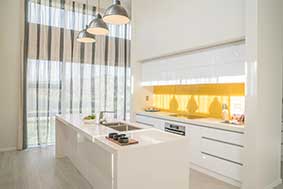Getting a new kitchen in your home is a big decision. It is a major financial investment plus it is a decision you will live with for several years. Here are some steps to make the process as smooth as possible and that will ensure you get a kitchen you love.
-
- Decide on Your Budget – It is important to set your budget before you start looking at kitchen styles or functionality. This will prevent you from getting into a situation further into the process where you have to make compromises because of financial constraints.
- Evaluate Your Current Kitchen – Next, look at your current kitchen from a style and functionality perspective. In terms of style, you may already have an idea of what you want your new kitchen to look like. What are the things you don’t like about the style of your existing kitchen, though? For example, did it become dated too quickly or do you think it is too dark?
As for functionality, identify things you like and don’t like about your existing kitchen. This could be anything from storage space to the design of the sink to the location of appliances. Pay particular attention to things that don’t work well and could be improved.
- Think About How You Use the Kitchen – It is also important to think about how you use your kitchen. A family kitchen that is used for meals, making packed lunches, doing homework, and everything else that goes on in a family kitchen is very different to a kitchen used only by adults. Will you entertain in the kitchen, for example, and what are your cooking preferences and habits?
- Decide on the Essential Elements – You may not be able to get everything you want in your new kitchen so it is important to decide on the essential elements. This includes everything from the quality of the appliances to the kitchen’s features to elements of the design. You might, for example, decide that a particular type of countertop is essential to your new kitchen, or you might want an oversize refrigerator. Prioritise what is most important.
- Think About Counter Space, Appliances, and Storage – It is the job of your kitchen designer to maximise storage and counter space while also ensuring all the elements of your kitchen are accessible and work together. You can have an input in this process too, particularly if you have lived in the house for a while and know the space well.
- Get Design Inspiration – This step only applies if you are still unsure of the exact design you want. The first tip is not to rush this part of the process as it is too important. The best advice is to get design inspiration from as many sources as you can. This includes reading interior design and kitchen design blogs and magazines, visiting kitchen showrooms, speaking to professional kitchen designers, and more.
- Find a Kitchen Designer and Installer – Finally, appoint a kitchen designer so you can take the next steps to getting your new kitchen. Make sure the kitchen designer has experience and delivers high-quality workmanship. Professionalism is important too – after all, they will be working not only in your home but in the most important room of your home.
By following the above steps, you will get the kitchen you have always wanted.

